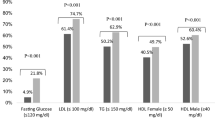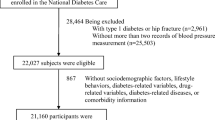Abstract
Summary
Type 2 diabetes is associated with an increased risk of hip fractures. We hypothesize that long-term glycemic variability predicts incident hip fractures. We demonstrated that HbA1c variability predicted incident hip fractures independent of mean HbA1c, suggesting the potential benefits of minimizing glycemic variability in addition to optimizing mean glycemia for bone health.
Introduction
Type 2 diabetes is associated with an increased risk of hip fractures, and a linear relationship between HbA1c levels and hip fracture incidence has been observed. We hypothesize that HbA1c variability also predicts incident hip fractures in type 2 diabetes.
Methods
Chinese individuals with type 2 diabetes aged ≥ 60 years were identified from electronic health records in Hong Kong between 2008 and 2012 and observed for incident hip fractures. Hip fracture was defined by the International Classification of Diseases (Ninth Revision) code 820. HbA1c variability was determined using standard deviation, adjusted standard deviation, and coefficient of variation of HbA1c measurements in the 5 years preceding the entry date. Multivariable Cox regression analysis was used to evaluate associations between HbA1c variability and incident hip fractures.
Results
A total of 83,282 participants were included. Their mean age was 71.3 ± 7.5 years, duration of diabetes 11.7 ± 7.7 years, baseline HbA1c 56.6 ± 13.5 mmol/mol (7.33 ± 1.23%), and median follow-up 6.8 years. All indices of HbA1c variability were significant independent predictors of incident hip fractures, with an adjusted hazard ratio of up to 1.29 (all p < 0.001), and remained to be independent predictors across groups of different intensity of glycemic control. Mean HbA1c ≥ 64 mmol/mol (8.0%) was associated with a 25% increase in incident hip fractures compared with mean HbA1c < 53 mmol/mol (7.0%).
Conclusion
HbA1c variability is an independent positive predictor of hip fracture in type 2 diabetes, across the spectrum of varying degree of glycemic control, while a high HbA1c is also not advisable from the perspective of bone health.

Similar content being viewed by others
References
(1998) Intensive blood-glucose control with sulphonylureas or insulin compared with conventional treatment and risk of complications in patients with type 2 diabetes (UKPDS 33). UK Prospective Diabetes Study (UKPDS) Group. Lancet 352(9131):837–853
Holman RR, Paul SK, Bethel MA, Matthews DR, Neil HAW (2008) 10-year follow-up of intensive glucose control in type 2 diabetes. N Engl J Med 359(15):1577–1589
(1995) The relationship of glycemic exposure (HbA1c) to the risk of development and progression of retinopathy in the diabetes control and complications trial. Diabetes 44(8):968–983
Leslie RD (1999) United Kingdom prospective diabetes study (UKPDS): what now or so what? Diabetes Metab Res Rev 15(1):65–71
Cavalot F (2013) Do data in the literature indicate that glycaemic variability is a clinical problem? Glycaemic variability and vascular complications of diabetes. Diabetes Obes Metab 15(Suppl 2):3–8
Gorst C, Kwok CS, Aslam S, Buchan I, Kontopantelis E, Myint PK et al (2015) Long-term glycemic variability and risk of adverse outcomes : a systematic review and meta-analysis. Diabetes Care 38:2354–2369
Janghorbani M, Van Dam RM, Willett WC, Hu FB (2007) Systematic review of type 1 and type 2 diabetes mellitus and risk of fracture. Am J Epidemiol 166(5):495–505
Lecka-Czernik B (2017) Diabetes, bone and glucose-lowering agents: basic biology. Diabetologia. 60(7):1163–1169
IDF 2017. IDF Diabetes Atlas - 8th edition
Man LP, Angela Ho AWH, Wong SH (2016) Excess mortality for operated geriatric hip fracture in Hong Kong. Hong Kong Med J 22(1):6–10
Strom O, Borgstrom F, Kanis JA, Compston J, Cooper C, McCloskey EV et al (2011) Osteoporosis: burden, health care provision and opportunities in the EU: a report prepared in collaboration with the International Osteoporosis Foundation (IOF) and the European Federation of Pharmaceutical Industry Associations (EFPIA). Arch Osteoporos 6:59–155
Li C-I, Liu C-S, Lin W-Y, Meng N-H, Chen C-C, Yang S-Y et al (2015) Glycated hemoglobin level and risk of hip fracture in older people with type 2 diabetes: a competing risk analysis of Taiwan diabetes cohort study. J Bone Miner Res 30(7):1338–1346
Lafage-Proust M-H, Roche B, Langer M, Cleret D, Vanden Bossche A, Olivier T et al (2015) Assessment of bone vascularization and its role in bone remodeling. Bonekey Rep 4:662
Ihnat MA, Thorpe JE, Ceriello A (2007) Hypothesis: the “metabolic memory”, the new challenge of diabetes. Diabet Med 24(6):582–586
Ke C, Lau E, Shah BR, Stukel TA, Ma RC, So W-Y et al (2019) Excess burden of mental illness and hospitalization in young-onset type 2 diabetes: a population-based cohort study. Ann Intern Med 170(3):145–154
Levey AS, Bosch JP, Lewis JB, Greene T, Rogers N, Roth D (1999) A more accurate method to estimate glomerular filtration rate from serum creatinine: a new prediction equation. Modification of Diet in Renal Disease Study Group. Ann Intern Med 130(6):461–470
Orsi E, Solini A, Bonora E, Fondelli C, Trevisan R, Vedovato M et al (2018) Haemoglobin A1c variability is a strong, independent predictor of all-cause mortality in patients with type 2 diabetes. Diabetes Obes Metab 20(8):1885–1893
(2017) Glucose concentrations of less than 3.0 mmol/L (54 mg/dL) should be reported in clinical trials: a joint position statement of the American Diabetes Association and the European Association for the Study of Diabetes. Diabetes Care 40(1):155–157
Tang CS, Zhang H, Cheung CYY, Xu M, Ho JCY, Zhou W et al (2015) Exome-wide association analysis reveals novel coding sequence variants associated with lipid traits in Chinese. Nat Commun 6:10206
Wong Y-K, Cheung CYY, Tang CS, Au K-W, Hai JSH, Lee C-H et al (2018) Age-biomarkers-clinical risk factors for prediction of cardiovascular events in patients with coronary artery disease. Arterioscler Thromb Vasc Biol 38(10):2519–2527
Woo YC, Gao B, Lee CH, Fong CH, Lui DT, Ming J et al (2020) Three-component non-invasive risk score for undiagnosed diabetes in Chinese people: development, validation and longitudinal evaluation. J Diabetes Investig 11(2):341–348
Lee CH, Cheung CYY, Woo YC, Lui DTW, Yuen MMA, Fong CHY et al (2019) Prospective associations of circulating adipocyte fatty acid-binding protein levels with risks of renal outcomes and mortality in type 2 diabetes. Diabetologia 62(1):169–177
Farrell C-JL, Martin S, McWhinney B, Straub I, Williams P, Herrmann M (2012) State-of-the-art vitamin D assays: a comparison of automated immunoassays with liquid chromatography-tandem mass spectrometry methods. Clin Chem 58(3):531–542
Therneau TGP (2000) Modeling survival data. In: Statistics for biology and health. Springer-Verlag, New York
Kleinbaum D (1995) Survival analysis-a self-learning text. Springer-Verlag, New York
Samelson EJ, Zhang Y, Kiel DP, Hannan MT, Felson DT (2002) Effect of birth cohort on risk of hip fracture: age-specific incidence rates in the Framingham study. Am J Public Health 92(5):858–862
von Friesendorff M, Besjakov J, Akesson K (2008) Long-term survival and fracture risk after hip fracture: a 22-year follow-up in women. J Bone Miner Res 23(11):1832–1841
Shen GS, Li Y, Zhao G, Bin ZH, Xie ZG, Xu W et al (2015) Cigarette smoking and risk of hip fracture in women: a meta-analysis of prospective cohort studies. Injury. 46(7):1333–1340
Wu Z-J, Zhao P, Liu B, Yuan Z-C (2016) Effect of cigarette smoking on risk of hip fracture in men: a meta-analysis of 14 prospective cohort studies. PLoS One 11(12):e0168990
Sogaard AJ, Holvik K, Omsland TK, Tell GS, Dahl C, Schei B et al (2016) Age and sex differences in body mass index as a predictor of hip fracture: a NOREPOS study. Am J Epidemiol 184(7):510–519
Puar TH, Khoo JJ, Cho LW, Xu Y, Chen YT, Chuo AM et al (2012) Association between glycemic control and hip fracture. J Am Geriatr Soc 60(8):1493–1497
Schisano B, Tripathi G, McGee K, McTernan PG, Ceriello A (2011) Glucose oscillations, more than constant high glucose, induce p53 activation and a metabolic memory in human endothelial cells. Diabetologia. 54(5):1219–1226
Hung YC, Lin CC, Chen HJ, Chang MP, Huang KC, Chen YH et al (2017) Severe hypoglycemia and hip fracture in patients with type 2 diabetes: a nationwide population-based cohort study. Osteoporos Int 28(7):2053–2060
Stratton IM, Adler AI, Neil HA, Matthews DR, Manley SE, Cull CA et al (2000) Association of glycaemia with macrovascular and microvascular complications of type 2 diabetes (UKPDS 35): prospective observational study. BMJ 321(7258):405–412
Penno G, Solini A, Bonora E, Fondelli C, Orsi E, Zerbini G et al (2013) HbA1c variability as an independent correlate of nephropathy, but not retinopathy, in patients with type 2 diabetes: the Renal Insufficiency And Cardiovascular Events (RIACE) Italian multicenter study. Diabetes Care 36(8):2301–2310
El-Osta A, Brasacchio D, Yao D, Pocai A, Jones PL, Roeder RG et al (2008) Transient high glucose causes persistent epigenetic changes and altered gene expression during subsequent normoglycemia. J Exp Med 205(10):2409–2417
Ceriello A, Esposito K, Piconi L, Ihnat MA, Thorpe JE, Testa R, Boemi M, Giugliano D (2008) Oscillating glucose is more deleterious to endothelial function and oxidative stress than mean glucose in normal and type 2 diabetic patients. Diabetes. 57(5):1349–1354
Chiang JI-H, Li T-C, Li C-I, Liu C-S, Meng N-H, Lin W-Y et al (2016) Visit-to-visit variation of fasting plasma glucose is a predictor of hip fracture in older persons with type 2 diabetes: the Taiwan Diabetes Study. Osteoporos Int 27(12):3587–3597
Holvik K, Ahmed LA, Forsmo S, Gjesdal CG, Grimnes G, Samuelsen SO et al (2013) Low serum levels of 25-hydroxyvitamin D predict hip fracture in the elderly: a NOREPOS study. J Clin Endocrinol Metab 98(8):3341–3350
Majumdar SR, Josse RG, Lin M, Eurich DT (2016) Does sitagliptin affect the rate of osteoporotic fractures in type 2 diabetes? Population-based cohort study. J Clin Endocrinol Metab 101(5):1963–1969
Johnston SS, Conner C, Aagren M, Ruiz K, Bouchard J (2012) Association between hypoglycaemic events and fall-related fractures in Medicare-covered patients with type 2 diabetes. Diabetes Obes Metab 14(7):634–643
An T, Hao J, Sun S, Li R, Yang M, Cheng G et al (2017) Efficacy of statins for osteoporosis: a systematic review and meta-analysis. Osteoporos Int 28(1):47–57
Acknowledgments
We thank the Hong Kong Hospital Authority for establishing a comprehensive electronic health record system for the analysis.
Author information
Authors and Affiliations
Corresponding authors
Ethics declarations
Conflict of interest
None.
Additional information
Publisher’s note
Springer Nature remains neutral with regard to jurisdictional claims in published maps and institutional affiliations.
Rights and permissions
About this article
Cite this article
Lui, D., Lee, C., Chan, Y. et al. HbA1c variability, in addition to mean HbA1c, predicts incident hip fractures in Chinese people with type 2 diabetes. Osteoporos Int 31, 1955–1964 (2020). https://doi.org/10.1007/s00198-020-05395-z
Received:
Accepted:
Published:
Issue Date:
DOI: https://doi.org/10.1007/s00198-020-05395-z




